- Clone
- Poly19057 (See other available formats)
- Regulatory Status
- RUO
- Other Names
- Keratin, type II cytoskeletal 6A, K6A, CK-6A, mK6-alpha, keratin-6A, 60-kD keratin, cytokeratin-6A, keratin-6-alpha
- Previously
-
Covance Catalog# PRB-169P
- Isotype
- Rabbit Polyclonal IgG
- Ave. Rating
- Submit a Review
- Product Citations
- publications
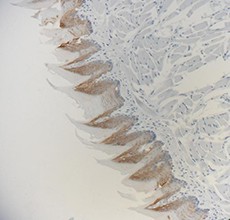
-

Staining of Mouse Keratin 6, on mouse tongue at a 1:5000 dilution. -

Total lysates (15 µg protein) from 293E transfected with or without mouse keratin 6A were resolved by electrophoresis (4-20% Tris-glycine gel), transferred to nitrocellulose, and probed with 1:1000 (1 ug/ml) purified anti-mouse keratin 6A antibody (clone Poly19057). Proteins were visualized using chemiluminescence detection by incubation with and HRP goat anti-mouse IgG secondary antibody (Cat. No. 405306, 1:3000 dilution). Direct-Blot™ HRP anti-β-actin antibody was used as a loading control (Cat. No. 643807, 1:8000 dilution). -

IHC staining of purified anti-mouse Keratin 6A antibody (Poly19057) on formalin-fixed paraffin-embedded mouse esophagus tissue. Following antigen retrieval using Citrate (Cat. No. 420901), the tissue was incubated with 1.0 µg/mL of the primary antibody 60 minutes at room temperature. BioLegend’s Ultra Streptavidin (USA) HRP Detection Kit (Multi-Species, AEC, Cat. No. 929501) was used for detection followed by hemotoxylin counterstaining, according to the protocol provided. The image was captured with a 40X objective.
| Cat # | Size | Price | Quantity Check Availability | Save | ||
|---|---|---|---|---|---|---|
| 905702 | 25 µL | 72€ | ||||
| 905701 | 100 µL | 231€ | ||||
Keratin 6A is a type II cytokeratin that belongs to the keratin family of fibrous structural proteins. The protein is expressed along with its partners KRT16 and/or KRT17 in the filiform papillae of the tongue, the stratified epithelial lining of oral mucosa and esophagus, the outer root sheath of hair follicles, and the glandular epithelia. The murine genome is known to have two keratin 6 (CK6) genes, CK6A and CK6b. Mutations in these genes have been associated with pachyonychia congenita.
Product DetailsProduct Details
- Verified Reactivity
- Mouse
- Antibody Type
- Polyclonal
- Host Species
- Rabbit
- Immunogen
- This monospecific polyclonal antibody was raised against a peptide sequence derived from the C-terminus of the mouse keratin 6 protein.
- Formulation
- Phosphate-buffered solution + 0.03% Thimerosal.
- Preparation
- The antibody was purified by affinity chromatography.
- Concentration
- 1.0 mg/mL
- Storage & Handling
- The antibody solution should be stored undiluted between 2°C and 8°C. Please note the storage condition for this antibody has been changed from -20°C to between 2°C and 8°C. You can also check your vial or your CoA to find the most accurate storage condition for this antibody.
- Application
-
IHC-P - Quality tested
WB - Verified - Recommended Usage
-
Each lot of this antibody is quality control tested by formalin-fixed paraffin-embedded immunohistochemical staining.
The optimal working dilution should be determined for each specific assay condition.
• WB: 1:1,000*
• IF: 1:500
• IHC: 1:500 - Application Notes
-
This antibody is effective in immunoblotting (WB), immunofluorescence (IF) and immunohistochemistry (IHC). This antibody has been successfully used in both frozen and paraffin embedded tissues.
*Predicted MW = 59.9 kD
This product may contain other non-IgG subtypes. -
Application References
(PubMed link indicates BioLegend citation) -
- Welm AL, et al. 2005. Proc Natl Acad Sci USA. 102:4324.
- Hu Y, et al. 2001. Nature. 410:710.
- Yuspa SH, et al.. 1989. J Cell Biol. 109:1207.
- Roop DR, et al. 1984. J Biol Chem. 259:8037.
- Easter SL, et al. 2014. PLoS One. 9:113247. (IF, WB) PubMed
- DiTommaso T, et al. 2014. PLoS Genet. 10:1004706. (IHC) PubMed
- Li Z, et al. 2007. Cancer Cell. 12:542. (IHC)
- Liang Y, 2011 Patholog Res Int. 2011:936794. (IHC) PubMed
- Frew IJ, et al. 2008. Mol Cell Biol.28:4536. (IHC) PubMed
- Smith BA, et al. 2012. Genes Cancer.3:550. (IHC) PubMed
- Johnson JP, et al. 2014 Cancer Geomics Proteomics. 11:115. (IHC) PubMed
- Sengupta A, et al. 2010. PLoS One. 5:12249. (IHC) PubMed
- Mikaelian I, et al. 2006. Vet Pathol. 43:36. (IHC)
- Li W, et al. 2007. J Biol Chem. 282:1161. (IHC, WB) PubMed
- Osmanagic-Myers S, et al.2006. J Cell Biol. 174:557. (WB) PubMed
- Kittrell FS, et al. 2011. Breast Cancer Res.13:41. (IF) PubMed
- Quante T, et al. 2014. Front Oncol. 26:168. (IF) PubMed
- Bayo P, Sanchis A, Bravo A, Cascallana JL, Buder K, Tuckermann J, Schütz G, and Pérez P. Glucocorticoid Receptor Is Required for Skin Barrier Competence. Endocrinology, 149: 1377-1388, Mar 2008. (IHC) PubMed
- Product Citations
-
- RRID
-
AB_2565052 (BioLegend Cat. No. 905702)
AB_2565052 (BioLegend Cat. No. 905701)
Antigen Details
- Biology Area
- Cell Biology, Cell Motility/Cytoskeleton/Structure, Neuroscience, Neuroscience Cell Markers
- Molecular Family
- Intermediate Filaments
- Gene ID
- 16687 View all products for this Gene ID
- UniProt
- View information about Keratin 6A on UniProt.org
Related Pages & Pathways
Pages
Other Formats
View All Keratin 6A Reagents Request Custom Conjugation| Description | Clone | Applications |
|---|---|---|
| Purified anti-mouse Keratin 6A | Poly19057 | IHC-P,WB |
Customers Also Purchased
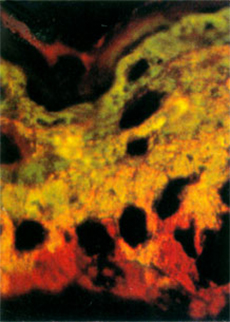
Compare Data Across All Formats
This data display is provided for general comparisons between formats.
Your actual data may vary due to variations in samples, target cells, instruments and their settings, staining conditions, and other factors.
If you need assistance with selecting the best format contact our expert technical support team.
 Login / Register
Login / Register 




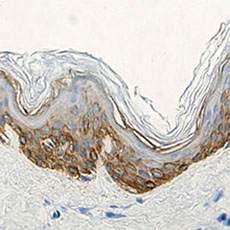
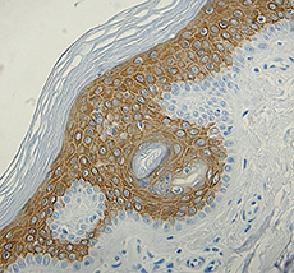
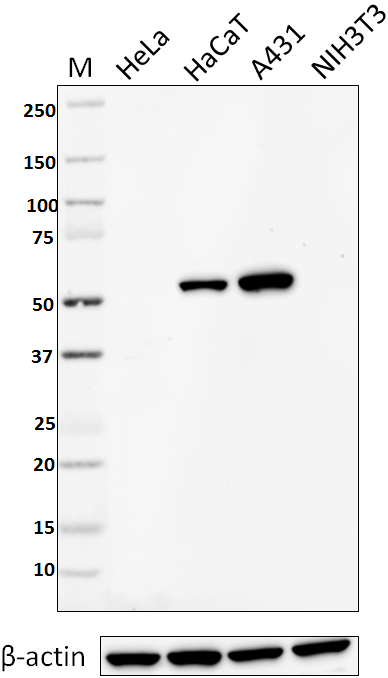


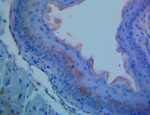



Follow Us